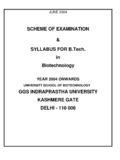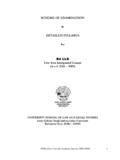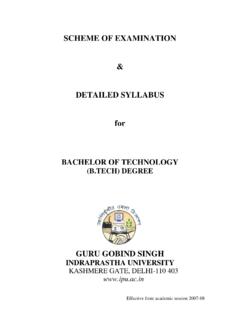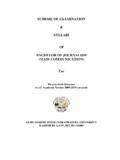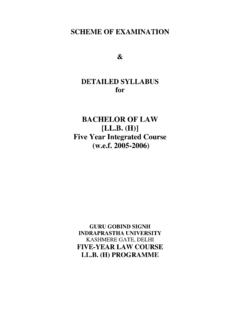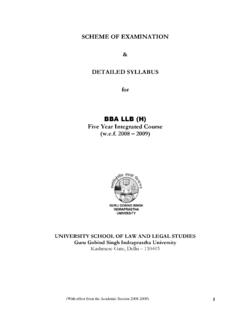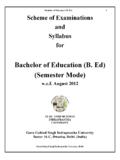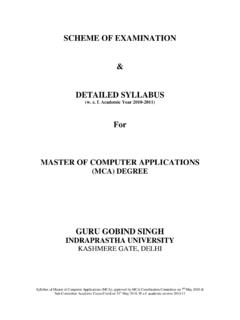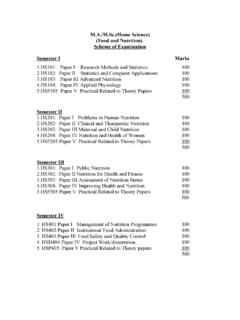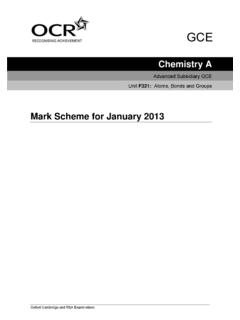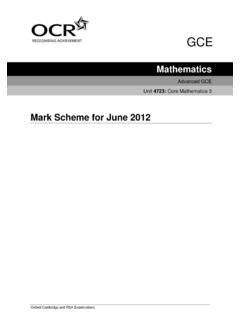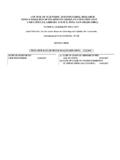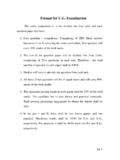Transcription of SCHEME OF EXAMINATION SYLLABI of Master of …
1 SCHEME OF EXAMINATION . &. SYLLABI . of Master of Business Administration (Software Enterprise management ). for Academic Session 2008-09. MBA (Software Enterprise management ). Criteria for Internal Assessment The internal assessment of the students (out of 40 marks) shall be as per the criteria given below: 1. Class Test-I - 15 marks (Individual Term Paper/Written Assignment/Project). 2. Class Test-II - 15 marks (Will be a written test to be conducted on the date communicated by the University 3. Individual Presentation/Viva-Voce/Group Discussion - 10 marks MBA (Software Enterprise management : Session 2007-2008 2. SCHEME of EXAMINATION MBA (Software Enterprise management ). First Semester Code Paper L/P Cr. No. SE 101 management Functions & Organizational Behaviour 3 3.))
2 SE 103 Business Communication 3 3. SE 105 Financial and management Accounting 4 4. SE 107 Quantitative Methods for Decision Making 3 3. SE 109 Managerial Economics 3 3. SE 111 Marketing management 3 3. SE 113 Java Programming 4 4. Practical SE 151 Java Programming Lab 6 3. Total 26. MBA (Software Enterprise management : Session 2007-2008 3. SCHEME of EXAMINATION MBA (Software Enterprise management ). Second Semester Code Paper L/P Cr/. No. SE 102 Business Research 3 3. SE 104 Human Resource management 3 3. SE 106 Financial management 4 4. SE 108 Business Environment 3 3. SE 110 Operations management 3 3. SE 112 System Analysis and Design 4 4. SE 114 Database management Systems 4 4. Practical SE 152 DBMS Lab 6 3. Total 27. MBA (Software Enterprise management : Session 2007-2008 4.))
3 SCHEME of EXAMINATION MBA (Software Enterprise management ). Third Semester Code Paper L/P Cr. No. SE 201 Financial Services management 4 4. Enterprise Resource Planning and Business 4 4. SE 203. Application Programming SE 205 Software Project management 4 4. Elective-I (Select any one group). Group 1 Human Resource SE 207 Human Resource Planning and Development 4 4. SE 209 Human Resource Payroll 4 4. Group 2 Production and Operations management SE 211 Materials management 4 4. SE 213 Production Planning and Control 4 4. Group 3 Marketing SE 215 Sales and Distribution 4 4. SE 217 Customer Relationship management 4 4. Group 4 Technical/Administration SE 219 Database Administration 4 4. SE 221 Operating Systems 4 4. Practical SE 251 Business Application Programming Lab 6 3.
4 SE 253 Summer Training Project - 2. SE 255 Minor Project Work 2. Total 27. MBA (Software Enterprise management : Session 2007-2008 5. SCHEME of EXAMINATION MBA (Software Enterprise management ). Fourth Semester Code Paper L/P Cr/. No. SE 202 Corporate Strategy & Policy 3 3. SE 204 Financial Accounting (ERP) 4 4. *Elective II (Choose any one paper). SE 206 Human Resource management 4 4. SE 208 Sales and Distribution 4 4. SE 210 Materials management 4 4. SE 212 Production Planning 4 4. SE 214 System Administration 4 4. Practical SE 252 Financial Accounting (ERP) Lab 4 2. SE 254 Elective Lab 4 2. SE 256 Dissertation - 8. SE 258 Seminar and Project Progress Report 2. SE 260 Comprehensive viva voce 1. Total 26. *The student will pursue the same elective area, which was opted in the third semester Note: 1.)
5 Total Credits = 106. 2. To obtain the degree a student shall require 100 credits MBA (Software Enterprise management : Session 2007-2008 6. Admission Process Admission to the MBA (Software Enterprise management ) Programme will be made on the basis of the Common Entrance Test. Students fulfilling the following eligibility criteria shall be eligible to appear in the Common Entrance Test. Eligibility Criteria B. Tech with minimum of 60% marks, M. Sc. (CS), M. Sc. (IT), M. Sc. (Electronics) with minimum of 60% marks, MCA with minimum of 60% marks. MBA (Software Enterprise management : Session 2007-2008 7. management Functions & Organizational Behaviour Code No. SE 101 L-3 T-0 Credits: 3. Objectives: This course is to acquaint the students with the basic nature of management , its process, tasks and responsibilities of a professional manager as well as organizational behavioral dynamics governing an organization.))
6 Course Contents: Introduction: Meaning and nature of management ; management systems and processes;. Tasks and responsibilities of a professional manager; Managerial skills. Decision Making: Organizational context of decisions; Decision making models; Problem solving and decision making techniques and processes, management by objectives. Organization Structure and Processes: Organizational climate, culture and managerial ethos; Organizational structure and design; Centralization and decentralization; Delegation and inter-department coordination; Managerial communication; Planning process;. Controlling. Behavioral Dynamics: Individual determinants of organization behavior: perceptions, learning, personality, attitudes and values, motivation; Job anxiety and stress.
7 Interactive Aspects of Organizational Behavior: Analyzing inter-personal relations; Group dynamics; management of organizational conflicts; management of change; Leadership styles and influence process. SUGGESTED READINGS: 1 Koontz, H. and Wehrich , H., management -A Global Perspective, 12., TMH. 2 Pareek, U., Organizational Processes, Oxford and IBH, New Delhi. 3 Robbins, S. P., management , 8th ed., New Jersey, Englewood Cliffs, Prentice Hall Inc. 4 Robbins, S. P., Organizational Behavior, 9th ed., Prentice Hall of India. 5 Robbins , Seema Sanghi, Organizational Behavior, 11th ed, Pearson Education. 6 Stoner, et. al., management , 6th ed., Prentice Hall of India. 7 Tayal, G. L., management , Sultan Chand and Sons, New Delhi. 8 Paul Hersey, Kenneth , management of Organisational behavior, th 8 ed.
8 , Pearson Edu. MBA (Software Enterprise management : Session 2007-2008 8. Business Communication Code No. SE 103 L-3 T-0 Credits: 03. Objectives: To equip the students with the necessary concepts & techniques and skills of communications to inform others, inspire them and enlist their activity and willing cooperation in the performance of their jobs. Course Contents: Introduction; Importance, Nature and Role of Business Communication Perceptions and Realities: Different Forms of Communication and their importance including body language Communication; with colleagues including Brain Storming Facing Interviews; Group Discussions Verbal Communication with colleagues and clients & telephonic conversation Written Communication: Individual communication-Letters and Memos Group Communication-Circulars & Notifications; Report Writing and Presentation; Writing Curriculum Vitae; Mass Communications-New Letters, Publicity Handouts, Instructions and Manuals ;Electronic Communication-Fax, e-mail, Internet and Multimedia Non Verbal Communication: Oral Communication: Legal Communication, Proposals, Agreements, MOU's &.)
9 Negotiations; Public Speaking; Handling the Press; Business Etiquette Suggested Readings : 1 Meenakshi Raman, Prakash Singh, Business Communication, Oxford University Press. 2 Scot Ober, contemporary Business Communication; 5th ed., wiley. 3 Locker, Kitty Kaxzcmarek, Stephen, Business Communication; McGraw Hill. 4 ; , , Business Communication;. MacMillan. 5 Francis Soundararaj, Speaking & Writing for effective Business Communication; MacMillan 6 Lesikar, and pettit, , Business communication; Theory and Application; 16th ed., AITBS. 7 Murphy, , Hildebrandt, and Thomas, ; Effective Business Communication; 7th Edition, Mc. Graw Hill, New York. MBA (Software Enterprise management : Session 2007-2008 9. 8 Fisher, D.; Communication in Organizations; 2nd Edition, Jaico Publishing House, Delhi.)
10 9 Krishna Mohan, Effective English Communication, TMH. Financial and management Accounting Code No. SE 105 L-4 T-0 Credits:04. Objectives: The basic purpose of this course is to develop an insight of postulates, principles and techniques of accounting and utilization of financial and managerial accounting information for planning, decision-making and control. Course Contents: Nature of Accounting Information: Accounting Concepts and Conventions, Accounting Standards, Understanding/Preparation of Financial Statements: Trial Balance, Profit and Loss account, Balance Sheet, Financial Reporting in India. Financial Statement Analysis - Comparative Statements, Common Size Statement, Trend percentage analysis, Accounting Ratio Analysis, Fund Flow analysis, Cash Flow analysis management Accounting: Costing- Utility of costing elements, Cost Sheet Problems, Inflation Accounting, Human Resource Accounting, Depreciation Methods and Accounting.

